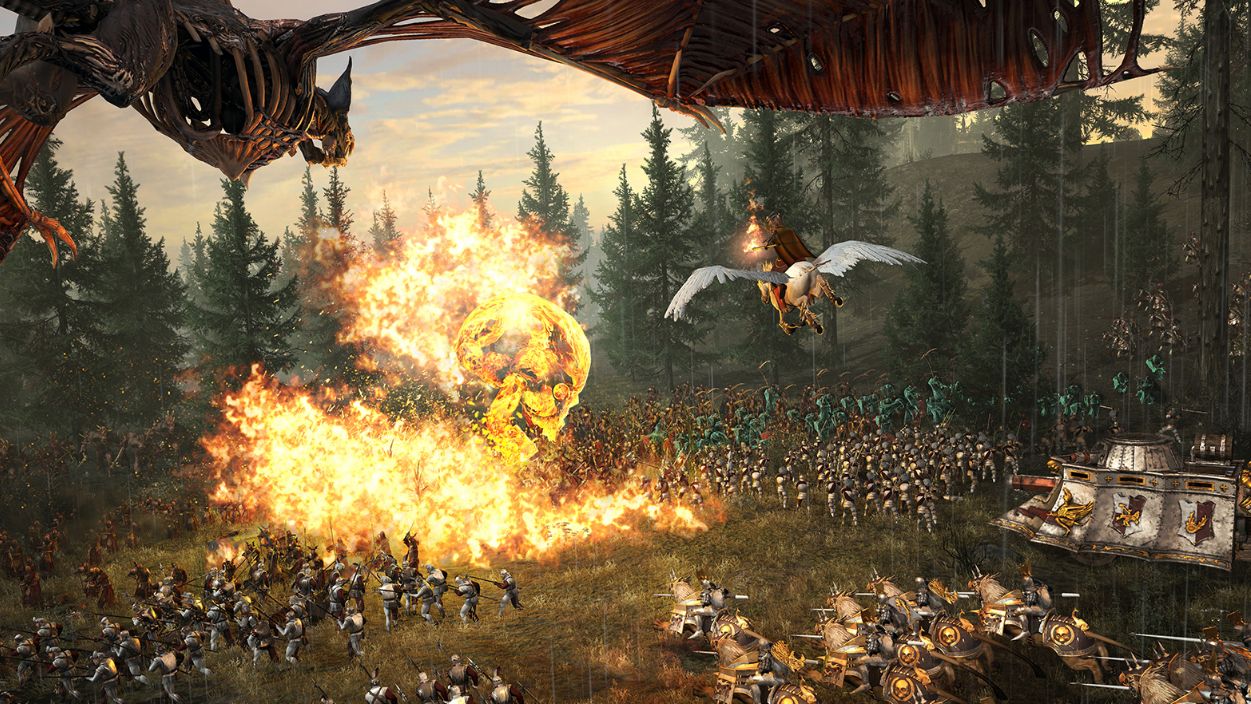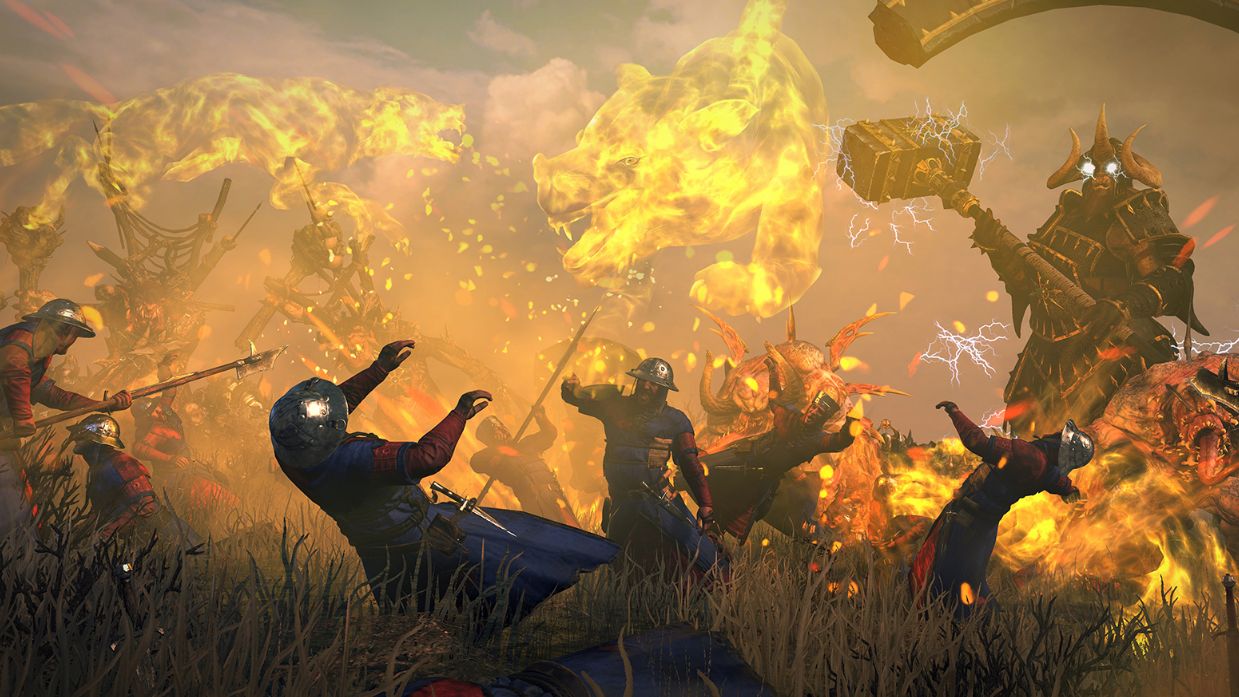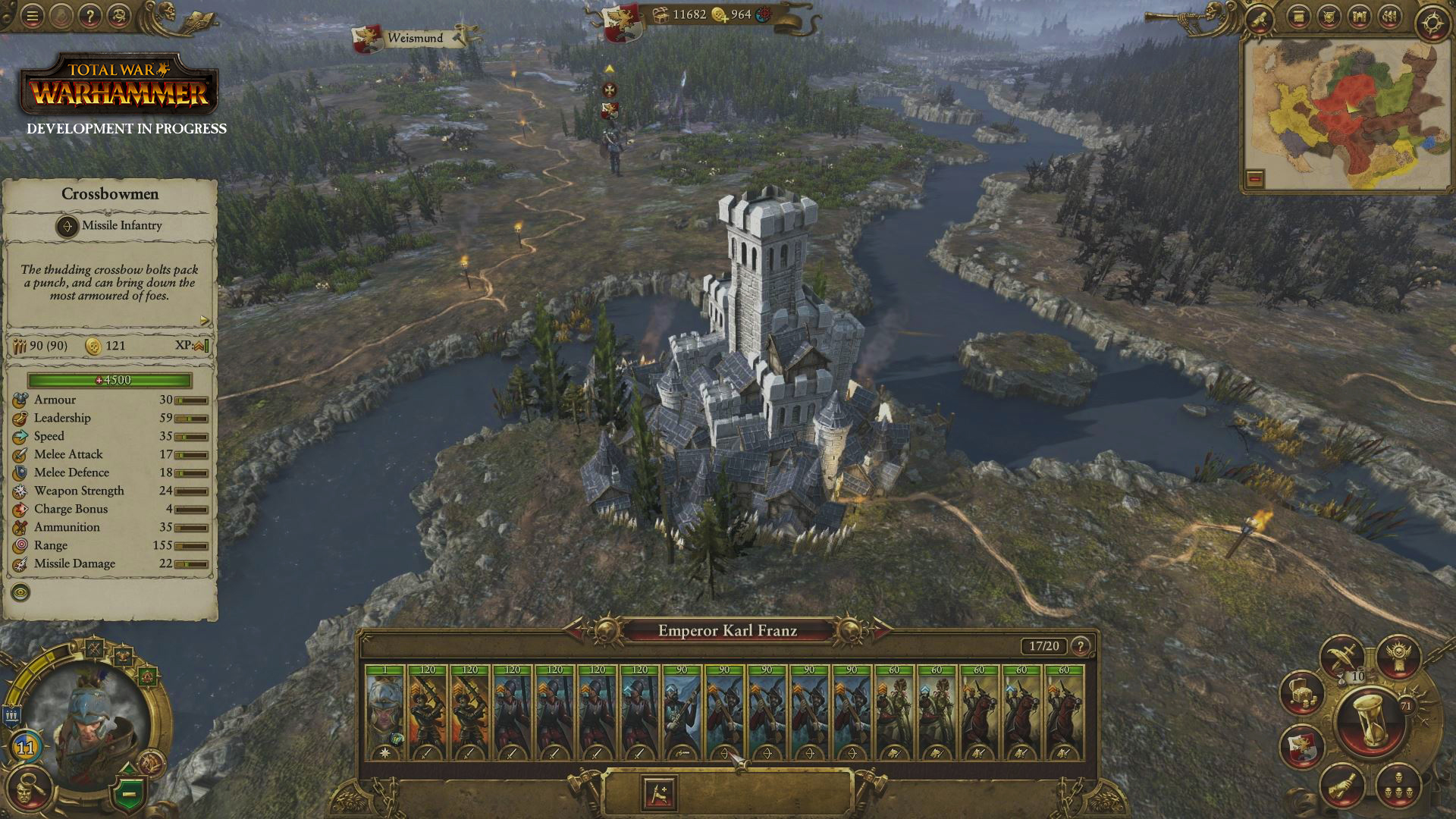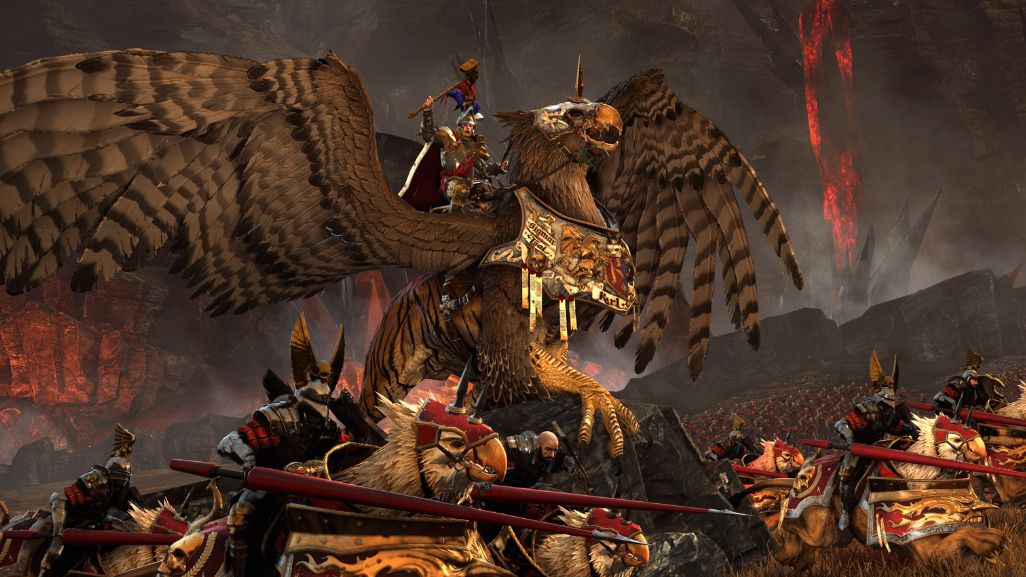Total War: Warhammer Empire guide
How to unify mankind and survive the Chaos invasion.

The Empire, in Warhammer Fantasy Battle’s setting, is the human confederation at the centre of the Old World. It’s modelled on a rough sweep of the historical Holy Roman Empire, which means that it has armoured knights, medieval foot troops armed with crossbows and handguns, and lots of artillery. It also means that the Emperor is elected from among the state heads that make up the Empire—and that the other heads aren’t very happy about your election.
The humans of the Empire might have the easiest start of any of the Total War factions. Though their neighbours aren’t allied, they aren’t exactly hostile (save perhaps for Graf Todbringer in Middenland) and they’re mostly desperate to survive. They also don’t have a huge cultural axe to grind against them, unlike the Vampire Counts and Greenskins. The Dwarfs and Brettonia even have a grudging respect for the Empire, which can blossom into an alliance when Chaos attacks.
However the Southern Greenskins and Eastern Vampire Counts aren’t that far away, and are very willing to push into the Empire proper once they’ve established themselves. Neglect the East and South for too long, and you’ll have big armies on your doorstop. Piss off the dwarfs or the humans by fighting any of them, and you’ll have a lot more problems to handle.
Imperial ambition
The Empire starts in a single region—Altdorf—but can swiftly and easily regain the other regions in its province. This province is situated in the West of the Empire, and you need to regain the whole place to get the Short Victory. That means definitely wiping out the Vampire Counts, and almost certainly killing off Archaon, the big boring suit of armour who heads up the Chaos faction. You’ve also got two Orc factions nearby who like to cause trouble.
The best way to proceed is to woo your neighbours, both human and Dwarfish. Many of them are well-disposed to you anyway, and crushing any wandering Greenskin tribes is a good way to make them like you more. The human factions are also exceedingly cheap dates because they’re so impoverished from fighting amongst themselves. A small bribe to them might only be as little as 500 gold, but will make them love you for turn after turn.
Of course, to get them to join your confederation, your need to get your military strength up, which means you need to afford at least two full armies. And that’s going to take some upkeep, which means you need to make money!
Getting Gelt
Despite his name (gold in German) and his magical control over gold, Balthasar Gelt is no help making the thousands you need each turn. Instead, you need to focus on the buildings in your province. The Empire, oddly, can build weaving sheds in every town which are cheap to start with and produce a steady stream of income. Each upgrade on them is less and less worth it, but will still pay off in 20-40 turns, so do them when you can.
The biggest gaming news, reviews and hardware deals
Keep up to date with the most important stories and the best deals, as picked by the PC Gamer team.
Of course, to upgrade them you need bigger cities, which means growth, so you’ll want to invest in farms wherever you can. The most efficient use of money is to just build the basic farm
Some towns have unique buildings, with special effects. For example, Grunberg has an expensive breeding stables which heavily buffs your cavalry and missile cavalry units and also has livestock farms, which give better growth than normal wheat farms. Always watch out for these when considering what to build—and always look at the building browser, because it’s hard to tell through the normal menu.
Also, remember that many building chains can only be fully-upgraded in a provincial capital—so if you want top-tier units in a region, ensure you build the smith, stables, foundry and temple of sigmar only in your provincial capital. That by itself uses up four of your provincial capital’s five spare slots—and many have unique buildings on them. For example, your faction capital Altdorf has a port and a unique college of wizards that you absolutely need to build. You might also want to build walls around them, which will take another slot.
It’s also worth noting that the Empire research tree is more formalised and smaller than the Dwarfs and Vampires. You only unlock three techs for research at a time, by building mid- and top-tier structures in your cities. Because of that, this is the faction it’s easiest to forget to do research with, and you won’t have much choice early on what to research.
These limits means that, unlike the Vampires, it’s hard to get all of your key buildings in one province and your military production is going to be more distributed. That also means you’re going to have defend a much larger core area than the Vampires against Chaos and its allies, so long-term the Empire has a harder game to play.
Head boy
Picking your commander makes a bigger difference for The Empire than most factions, because the choices are very different. Emperor Karl Franz upgrades as he levels up to be one of the best fighters and/or leaders in the game. And he can eventually unlock his griffon Deathclaw which hugely increases his lethality. He also starts with halberdiers, knights, and handgunners and allows your faction to move slightly further on the campaign map, which is always useful when chasing enemy armies down... or running away.
Balthasar Gelt, by contrast, is a wizard, who has a unique magic school to use, the lore of Metal, which has lots of damage-oriented spells that are particularly useful against heavily-armoured troops—e.g. Chaos Warriors and Chosen. He’s hugely fragile in combat though, so needs to be kept back until he can unlock his pegasus. He starts with better units than Karl Franz, in my opinion—a lethal mortar, anti-infantry greatswords and skirmishing outriders.

Loads more heroes
The Empire has a slightly larger selection of heroes because it has three wizard types. (It should have eight but that was a lot of work for one faction.) The wizards get to select from the lore of Light, Heavens or Fire. Fire is straight flaming damage-dealing, heavens (also known as Celestial) can call down lightning bolts and comets, and Light is focused on buffing, though it can also ‘banish’ enemies with a moving vortex spell.
The other three heroes are more traditional fighter types. The Witch Hunter is a fine-boned assassin, with pistols that he uses in melee and at range, and a special ability that can kill almost any other enemy in a few shots. The Warrior-Priest of Sigmar can buff troops around him, as well as being a solid melee fighter. And the Imperial Captain is just a tanky soldier, like an inferior versus of Karl Franz.
Uniquely to the Empire, Heroes and Lords can also be assigned to specific Imperial Offices, which give them and your Empire bonuses to income. You should always fill these if you can, as it costs you nothing, gives your characters some fun titles and buffs your faction heavily. Remember to keep changing it as you recruit more characters and they level up, as that allows them to access the higher tier offices.
Men of the line
The Empire has a big array of troop types. They’re roughly divided into infantry, cavalry, missile cavalry and war machines.
The basic infantry of the Empire are average. Spearmen, Swordsmen and Spearmen with shields feel like they were scraped straight out of previous Total Wars. They’re not as bad as the Vampire’s basic zombies and skeletons, but they’re pretty poor against almost any other race.
However, the next step up is much better. Halberdiers are great against cavalry and monsters, with armour-piercing weapons that give them bonuses against large enemies, whilst Greatswords are your elite infantry, with two-handed weapons, heavy armour and great leadership—they’re the only humans who can go toe-to-toe with Black Orcs and Chaos Warriors.
They also have a minimal set of missile troops, in their crossbowmen and handgunners. Neither of these are as good as the dwarven equivalent, especially not in melee, but they’re cheap and effective.
Horsing around
The Empire thrives on its knightly orders, and the ones on display here come in four varieties of shock cavalry. The basic Imperial Knight is pretty good by himself, but he’s outmatched by the Reiksguard Knights, who themselves are knocked into a cocked helmet by the Demigryph Knights, who are faster, better armoured and better fighters, and come in anti-large and anti-infantry varieties.
More fun than those are the mounted handgunners. The headstrong Pistoliers are very fast with short-ranged pistols whilst the Outriders have anti-armour handguns or anti-infantry grenade launchers but are less maneuverable. All three of these unit types get vanguard deployment, meaning they’re perfect for harassing an enemy force or taking out artillery—though it has to be remembered that they’re missile cavalry, not fast cavalry so they need to stay OUT of melee.

Bat out of Hellblaster
It feels a bit off to say this, as a committed tabletop Dwarf player, but the Imperial artillery in this game is rather good. Mortars can fire over hills, Cannons can blow enemy monsters and formations to bits, the Hellblaster volley gun just rifles through armoured troops, Hellstorm Rocket Batteries can hit a wide area inaccurately, and the Luminark of Hysh is literally a giant-killer.
If Da Vinci designed a tank, you might get something like the Steam Tank. It has a cannon on the front, the strongest armour in the game, horrifying charge damage and causes terror. Every army should have one.
Essentially, the faster you max out the Foundry building chain, the better. Guns are expensive to maintain, but a solid infantry line with an artillery group and cavalry waiting on the wings is classic Total War.
The Imperial battle manual
Whilst all these troops make the Empire nicely flexible, able to field strong cavalry armies, reasonable infantry troops, and hideously overpowered artillery forces, they are missing some elements. They have no recruitable flying units—they’re restricted to just a couple of heroes that when levelled-up can ride pegasi and griffons. And they have no monstrous units, unless you count the Steam Tank (which can have problems if it gets stuck in melee.)
From the tabletop game, they’re also missing their ‘detachments’ special rule, which allowed them to recruit smaller units of troops to protect their larger units’ flanks. That means tabletop Empire players might find their infantry much more ‘squishy’ than they’re used to.
Against the Dwarfs, the Empire has a straightforward strategy. Dwarven artillery is supposedly better than your stuff and their infantry are better too. However, they don’t have either magicians or cavalry and their slowness means that they can’t chase your troops down if they retreat. Against Dwarfs, use your shock cavalry if you’ve got them, close the distance quickly and pull them out to re-charge if you can. Watch out for gyrocopters and gyrobombers as you’ve got no flying units to take them down. And make use of your magical advantage to break up their formation with top-end vortex spells.
Against the Greenskins, the Empire struggles a little more. Goblins are no threat, except if they spit out a lethal spinning fanatic into your troops—don’t risk expensive cavalry on them. With no monstrous units of your own, trolls and giants can be problematic, so they need pinning down with halberdiers. Similarly, the Orc infantry units are normally stronger and tougher than your equivalents, but they have terrible leadership, so break them with flanking attacks and missile fire. Orc units will often reform after breaking, so keep your shock and missile cavalry ready to cut them down when they run.
Against the Vampire Counts, defend your artillery! The wide variety of Vampire flying and vanguard deployment units means it’s worth leaving a unit of spearmen and swordsmen with your gun emplacements, and possibly some handgunners and outriders too—only the Terrorgheist and Hexwraiths will still be a threat, but if they send one of those after your guns, then they’re wasting them. Your infantry should be able to defeat their basic troops with ease, but don’t rush into combat—use your artillery to weaken them first. Their monstrous creatures have low leadership, so just surround them with halberdiers. And always, always, target their general with your heroes, cavalry and wizard—if you can take them down, the army will fall apart immediately. (The Witch Hunter is exceptionally useful here.)

The Imperial space invaders
As the Empire, you will fight Chaos, and you won’t like it. Though the lower level Marauders and Hounds are less of a threat, the Chaos Warriors, Chosen and Chaos Knights are superior to nearly all your units. And let’s not start talking about monsters like the Dragon Ogres, Chaos Giants, Shaggoths, Chaos Lords and Chaos Spawn. If you can hit them with artillery fire, that’s great, so they’re already damaged when they get into close range. Then it’s a matter of making sure you pin them with the appropriate units and survive long enough to hit them with your cavalry from the sides and/or rear. Watch out for their magic, as it’s just as good as your own.
It’s worth noting; when Chaos does invade, the Empire, Dwarfs, Bretonnians and other human factions become a lot more friendly. Military alliances to defeat Chaos and their Norscan allies are essential. Defeat them and you’ll find any surviving human factions are much more well-disposed to you, making reforming the Empire a formality—assuming the Vampires haven’t taken the chance to attack from behind whilst you were doing it.
For Karl Franz, Sigmar and the Empire!
That’s the Empire army—balanced, varied and very much like a traditional Total War army. They’ve the easiest diplomacy of anyone in the game, the best artillery (sorry Dwarfs) and the best selection of mounted units. If you can survive the Chaos invasion, then your Empire should reign supreme.
For more Total War: Warhammer guides, check out our beginner's guide, world guide, Dwarf faction guide, Vampire Counts faction guide and Greenskins faction guide.

